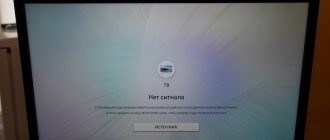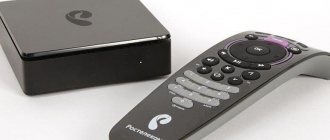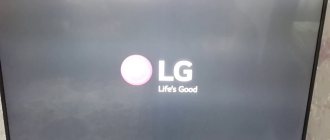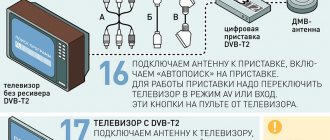According to statistics, the most common problem among digital television viewers is the situation when there is no signal on the TV. The inscription can appear both on a digital TV with a built-in DVB-T2 tuner, and on a connected external set-top box (receiver, tuner).
The notification may be slightly different on each TV, but the essence remains the same. Most often the TV says “No signal or weak signal.” Additionally, recommendations are given on what to do: “Check the antenna cable connection” or “Select the signal source.” This gives us a clear understanding of the reason for the inscription on the TV screen.
This means that the problem is either in the signal (the antenna does not work or is simply not connected), or the TV is now set to a different picture mode. In the latter case, for example, instead of terrestrial TV, the display mode via the HDMI interface can be selected.
The appearance of the notification is not affected by the brand of the TV. This applies to all popular brands (Samsung, LG, Philips, Sony, Xiaomi, Toshiba, Dexp and others) and less. It also doesn’t matter whether it’s a regular TV or Smart TV.
Incorrect source selected
A TV is a device that displays pictures from a source that supplies video and audio signals (or separately). Therefore, you need to make sure that the source from which you now want to display images is specified in the settings. If the source is set incorrectly, the picture simply will not be displayed. Consequently, the device will write that there is no signal.
The button on the control panel is always responsible for selecting the source. It is signed “SOURCE”, “INPUT”, “AV”.
If this button is not there, then you need to press the “HOME” button (indicated by a house icon). Next, select the source menu in the main menu and set the source from which you want to display the picture.
- If you need to watch via HDMI, select the item of the same name.
- When you need to watch digital TV through an antenna, you need to select the item “TV”, “Antenna”, “Broadcast”, “Live TV” or similar.
Selection and installation of a mast
Another pressing practical task is the installation of the mast. It is optimal to place the bracket directly on the wall, using the height of the house. There are also brackets on sale that are attached to the gable roof beam with self-tapping screws. An added bonus is that you can install it alone.
Another common budget solution, time-tested, is to use a “sushina” (dried wood, pole) tied to a stepson (reinforced concrete or metal post, dug close to the house).
Installation of the mast on the gable
You can’t go past the less common option - a telescopic mast made of several links. It can be secured in a vertical position with retractable brackets to the house. The advantage of the solution is that grounding, although not carried out in compliance with all GOSTs, is provided automatically. There is a considerable probability that the discharge will not go to the TV or receiver.
Before installing the mast, it is better to think about proper lightning protection. Unfortunately, there are numerous nuances and subtleties here. so that it is almost impossible for a non-professional to protect equipment from lightning. Therefore, during lightning strikes and in advance, it is better to de-energize the system and disconnect the antenna from the TV.
HDMI problem
If there is no signal on the TV via HDMI, and the source is set correctly, it is possible that the reason for the inscription lies in the cable itself.
Often, even if the cable is working, it does not perform its function. Sometimes it is enough to replace the cable and everything becomes working; the screen no longer says that there is no signal.
If replacing the multimedia cord does not help, there are several reasons:
- failure of the video card on a computer or laptop;
- original current versions of drivers are not installed on the computer device;
- malfunction of television equipment, you need to reset the settings to factory settings or flash the firmware;
- hardware malfunction of the TV, hardware failure, damage to the antenna or other port to which the signal is received.
In the latter case, it is impossible to solve the problem yourself without experience. You need to contact a service center for diagnostics and repairs.
Why does the TV signal disappear? Lifehacks for restoring digital TV reception
98% of TV viewers’ problems with digital terrestrial TV are related to user equipment or reception conditions: the location of the house, topography, buildings, and in the summer also with blossoming foliage. The root of difficulties with TV reception is often in the antenna. Based on the hotline data, RTRS specialists have compiled the Top 5 problems of TV viewers and offer life hacks to solve them.
1. “Whiskers” and “dryers”, or an unsuitable antenna
“The first multiplex does not work, the second has interference,” is how many complaints about the hotline begin. First of all, it is important to understand what kind of antenna the viewer has. Typical answer: “I don’t know what kind of antenna I have. It hangs very high on a pine tree, and they put it up with my mother many years ago.”
A little theory. Digital terrestrial television shows without interference; it is either in excellent quality or not at all. Therefore, in cases where the picture on the screen is either clear or completely disappears, the diagnosis is clear: the antenna is receiving the signal at the limit of its capabilities. And any change in reception conditions—blooming leaves, rain, a car passing by—changes the signal to such a level that its power is no longer enough for this antenna. In analog television there would be interference on the screen. “Digital” disappears completely. The conclusion is simple: you need to choose an antenna that is suitable for your location so that it gives the TV or set-top box a signal of sufficient power.
Antennas can be indoor or outdoor. The room is located in the apartment and is suitable if the TV tower is located in direct line of sight. If the distance to the tower is more than 10 km, an external one is needed. It is installed on a balcony, facade or roof.
Based on the frequencies received, antennas are divided into meter (analog channels), decimeter (digital channels) and all-wave (“analog” and “digital”). By 2021, more than 12 million Russians were receiving “analog” in the meter range: for example, with “mustache” or “polka” (“dryer”) antennas. They are ineffective for digital reception. Those who did not have time to update their equipment and tried to set up “digital” on a new receiver with an old antenna were faced with the same periodic loss of the TV signal. The old antenna catches something, but not always. The problem can only be solved by replacing the antenna with a decimeter one. The most suitable type is “Christmas tree”.
Less commonly, reception difficulties arise due to signal overamplification. Based on the type of amplification, there are active antennas (with an amplifier) and passive ones (without it). Excessive gain causes interference. Therefore, you should not use an active antenna near the tower. An amplifier is needed at the dacha, in rural areas, at a great distance from the tower in the city.
If the antenna type does not suit the reception conditions, it is better to replace it.
“Wrong turn”, or incorrect antenna orientation
The problem of insufficient signal may be caused by the receiving antenna “looking in the wrong direction.” A viewer from Zheleznovodsk complained about short-term interruptions and freezes in the signal. It turned out that the antenna was turned in the opposite direction from the city TV tower. Because of this, the signal level was weak, and the error level, on the contrary, was high. The same problem - the slightest change in reception conditions, and the signal disappears. Rotating the antenna solved the problem. And such cases occur regularly.
An interactive map on the website rtrs.rf will help you orient the antenna to the nearest tower. After connecting to the TV (or set-top box) using a cable, monitor the signal level and quality indicators on the TV screen. Slowly rotate the antenna around its axis. Focus on the TV signal intensity and quality scales. Achieve the best performance: signal level - at least 60%, quality - 100%.
Sometimes a “wrong turn” doesn’t cause disruptions, but it does deprive local news. A TV viewer from the village of Pizhma in Mari El pointed the antenna towards Sanchursk (Kirov region) and received Kirov news on air. To watch local Mari programs, he had to turn the antenna towards Yoshkar-Ola.
“Know its place”, or incorrect antenna placement
“Reception rates for multiplexes vary from 0% to 75%,” writes a TV viewer. It turned out that his private house is located 50 meters from a dense forest, and the antenna is installed at a level of six meters from the ground.
Raising the antenna higher often solves the reception problem. At large distances from the television tower and near natural obstacles, the recommended height for placing the antenna is 10 meters from ground level.
You should not place the antenna in the attic under a metal tile roof: this shielding surface interferes with the passage of the signal.
In the case of an indoor antenna, the window sill that faces the tower is best suited. If there is no such window, it is recommended to receive the reflected signal. For example, point the antenna at the wall of a neighboring house. Sometimes you will have to move the antenna to another room.
Spoons, forks and beer cans, or the disadvantages of homemade antennas
A resident of the village of Erofey Pavlovich, Amur Region, managed to receive TV on a tablespoon, but the signal kept disappearing.
Homemade products are also made from aluminum table forks, from the back grilles of refrigerators, from internal combustion engine head gaskets, from welding electrodes, from fishing nets, from gymnastics hoops and even from beer cans.
Successful models do occur, but rarely, as they require sufficient knowledge in the field of physics and radio engineering. To reliably receive a TV signal, it is recommended to receive the signal not “by wire”, but using a factory certified antenna.
Take care of the cable again, or why it is important to check connections
If the signal is lost, it is worth checking the cable connections between the antenna and the receiver. There is a known case when a TV viewer clamped the antenna cable with a bag of potatoes. The cable became disconnected from the TV and the signal was lost. The viewer discovered this after a week without TV.
The denser the cable braid and the thicker the central core, the stronger the cable.
The cause of unstable TV reception may be a damaged - oxidized - connector on the TV to which the antenna cable is connected. If you clean the connections and replace the connector, the reception of TV channels will be restored.
In case of problems with TV reception, it is recommended to check the location of the antenna cable connection to the outdoor antenna installed on the roof of the house. There the connector is no less susceptible to oxidation.
Operator repair work
If you use television services provided by your provider, and the set-top box says there is no signal, the provider may be carrying out maintenance or repair work.
When you turn on the digital set-top box, there may be no video signal due to the usual freezing of the equipment. Restart the set-top box and check operation. If this does not help, contact support to clarify the details of the repair work. You can view other notification channels:
- Official website of the provider.
- Information line in a TV set-top box.
- Mailing about work being carried out at the appointed time.
Only 10 out of 20 digital channels are shown, how to fix
Watching TV is an opportunity to relax and unwind, see what is happening in the country, enjoy your favorite series or TV show. What should I do if 10 out of 20 channels are missing? Is it possible to solve this problem on your own? Can. Over the past couple of years, the number of complaints from digital subscribers has increased just after the channels were updated on the set-top box and certain positions from multiplexes 1 and 2 disappeared. Therefore, the question of why 10 channels disappeared and what to do if they previously functioned is relevant.
Most likely, the reason for this situation is the difficulty of signal reception associated with technical work or the characteristic features of the “digital” operation. Since only from the beginning of this year a complete transition to digital has been carried out, there is a possibility that the signal is not received as well as needed. Moreover, RTRS notes that at the moment the work has not yet been stabilized, so there are difficulties in certain regions of the country. So the question of why the channels disappeared will be considered relevant for a long time until the signal supply is finally stabilized in different parts of the country.
What to do in such a situation? In order to find missing channels on digital television, you need to search for channels again or reflash the receiver.
Manual search
Searching in this mode is necessary if the channels in the auto search are duplicated. Tuning should only be done for the repeater station in your area when the strongest and most stable signal is received.
To obtain information about repeaters in your region, use the Interactive Digital TV Map and find the service for your region. The following step-by-step setup is a typical example:
- On the remote control of the tuner (digital set-top box), press the “Menu” or “Menu” button.
- In the menu that opens, select “Search for channels” and click the “Ok” button.
- Next, activate “Manual Search”.
- Fill in or select from the list provided the data for your region received from the map.
- Use the arrows to navigate to the “Search” item and start the process.
- Wait for it to complete.
Digital television is a new generation of information reception and transmission. With the high quality of the resulting image and sound, malfunctions and failures in the equipment are rare. Often the problem lies in the little things, and you should look for it on the surface, without delving into complex processes.
Final setup
After adjusting the compass and coverage map, you can try to increase the signal that appears. Display the signal strength scale and play around with the antenna. Rotate the antenna in different planes with slow movements. At the same time, look at the scale. With rotations the bar will change value.
Sometimes there is a delay in level updates. Therefore, you need to fix the antenna briefly in each position. With this simple action you can achieve the highest signal quality.
Once achieved, make the final fixation of the antenna. Poor fastening will cause the structure to change position due to strong gusts of wind, which will affect the quality of reception.
Additionally, secure the cable so that it does not dangle. Strong vibrations can cause the cable to be torn off from the antenna or the structure to shift.
Check the circuit
You could start by adjusting the location and direction of the etheric structure. But there may be a situation when the antenna is positioned correctly. Therefore, in order not to waste energy on the antenna, it is better to first analyze the circuit.
- Inspect the antenna. The external structure may become damaged over time or due to careless installation. Check to see if the vibrators (receiving elements) are damaged. Also check the quality of the cable connection to the antenna. The cable core and screen must be connected directly to the antenna or amplifier board. It is not allowed to short the screen to the central core. In the best case, there will be no signal, in the worst case, the set-top box may fail due to a short circuit.
- Inspect the entire length of the cable. Any strong bends in the wire or squeezing become a reason to check the cable. The integrity of the cable is checked by a tester.
- Any connections, for example, between two parts of a cable, must be made through an adapter connector. Twisting is allowed as a last resort if there is no adapter at hand. A good alternative is to solder the cable. It is possible that during twisting and insulating the connection point, the shielding layer shorted to the copper core of the cable. A short circuit is also possible when installing an F-plug. Therefore, it is advisable to check the quality of installation of F-type connectors at the ends of the cable.
If there are no problems with the cable, then the only possible reason why there is no digital television signal is poor antenna performance.
Poor performance refers to the inability to receive a weakened signal or incorrect directionality.
Smart TV software update
If you are the owner of an LG, Sony, Samsung or other popular brand marked Smart TV, the reason may lie in a software update that occurred automatically, but for some reason destroyed the channel settings.
It is possible that the update may not have installed or another error may have occurred, therefore:
- Turn off the TV and unplug it - this is very important. You need to completely unplug the device from the outlet and wait about 20-30 minutes. This instruction manual is available on almost all official websites of TV manufacturers.
- Turn on your device. Let the TV connect to the Internet.
- Use your remote control to open Settings.
- In the “Support” section, select “Software Update” and update the firmware to the latest version.
- Then go to the “Broadcast” section and check the operation of the channels. If the screen shows a black square, go to the channel selection and automatically find them again.
What to do if there is no signal only on certain channels
“Digital” is transmitted in packets – multiplexes. Each broadcasts 10 TV channels. A separate set of equipment at the television station is responsible for the operation of the multiplex. This is a good solution, because if there are problems with any multiplex, only 10 digital television channels are lost. The TV channels remain in the list on the TV. But when you switch the set-top box to the channels of a multiplex that is currently not working, the screen will write “No signal.”
You can make sure that the problem is common by surveying the residents of your home. Find out from another person who watches over-the-air channels. If your neighbor has lost the signal on the same list of channels, it means there is a widespread problem. We need to wait until the problems with the restoration of the TV signal are resolved.
Additionally, study the information on the rtrs.ru service. Providers notify viewers about interruptions in broadcasting. You can prepare in advance for future outages due to maintenance or other reasons.
External reasons
Partially this topic has already been touched upon earlier. What should I do if problems with the video signal occur after strong wind, rain or snow? First of all, you need to establish the initial direction of the antenna or satellite dish. It cannot be ruled out that a bad picture is a consequence of obstacles that have appeared: buildings, branches, trees. If possible, correct the problem, for example, cutting off the tree branch that is interfering with the signal.
What to do in situations where there is no signal on TV due to obstacles that you do not have the right to remove? For example, neighbors built a new building or expanded their house. The easiest way to solve the problem is to change the location of the TV antenna or satellite dish.
If the antenna/dish was initially installed correctly, but its direction changed after the wind, then this can also be considered the reason why when you turn on the TV you see the message “No signal”.
First of all, you need to adjust the turning angle of the dish or antenna. Pay attention to the direction of your neighbors' antennas, do everything the same as theirs. To make the most fine adjustments, use the angle calculator. You can find it on the provider’s official website. First, enter your location information. To get the most accurate information, use information obtained from your smartphone's GPS. The program will automatically calculate in which direction you need to point the antenna to increase signal reception quality.
Sometimes the image quality can deteriorate noticeably during heavy rain or wind. This is a completely natural phenomenon. Bad weather negatively affects signal quality. Unfortunately, you are unlikely to achieve ideal picture quality. You can try moving the antenna or dish to a more secure location if it matches the values obtained from the angle calculator.
Do weather conditions affect
Digital TV signals are transmitted in encrypted form. Therefore, any interference, including weather conditions, does not have a significant impact on the quality of viewing or loss of the TV signal.
But after a thunderstorm, if the TV signal power is low, the value may decrease further. The air is ionized, and this is a deteriorating factor for broadcasting “digits”.
There are factors that completely turn off digital television for a while. For example, solar interference occurs twice a year. The phenomenon lasts for several minutes each time. Any on-air transmission is stopped, be it digital terrestrial or satellite television.
Methods for receiving digital TV channels
You can catch numbers in several ways:
• Essential;
• Cable;
• Sputnikov.
The signal for terrestrial TV is distributed using terrestrial repeater towers. In order to receive it, you need an antenna. Using this technology, the image is transmitted free of charge. But using this method, the TV often does not pick up the signal well. Because the quality of the picture is affected by where the tower is located, what the weather is like outside, and many other factors.
Cable television is most often used in apartment buildings. In this case, the signal is transmitted via a cable that is connected to a common antenna. However, you have to pay for it and it cannot be used in private homes. Satellite signal transmission is carried out by satellites, and it is received by a special dish. This method allows you to receive the largest number of channels. But you have to pay for it and buy additional special equipment.
Of all these methods of receiving numbers, terrestrial is the cheapest and most accessible. But the picture quality leaves much to be desired.
If using an indoor antenna
Home antennas can work efficiently only if two conditions are met - the repeater is as close as possible and in direct line of sight. That is, there are no obstacles that reflect or absorb the radio signal. In the latter case, you can place the indoor version of the antenna even in the center of the room. Then the signal will pass through the window and successfully arrive at the antenna.
If there are no ideal conditions, then the home structure must be placed near a window, for example, on a windowsill. But it's better to sit higher.
Installation on a window via a stand
The inner metal layer inside plastic windows acts as shielding and does not allow signals to pass through. Take this into account if the antenna is flat and is completely (or partially) located behind a metal window frame.
Powerful household appliances that emit electromagnetic waves can interrupt the TV signal indoors. Therefore, it is worth placing the TV antenna in another room, away from electrical sources. mag. radiation. Although DTV is resistant to interference, strong interference can still affect the display.










